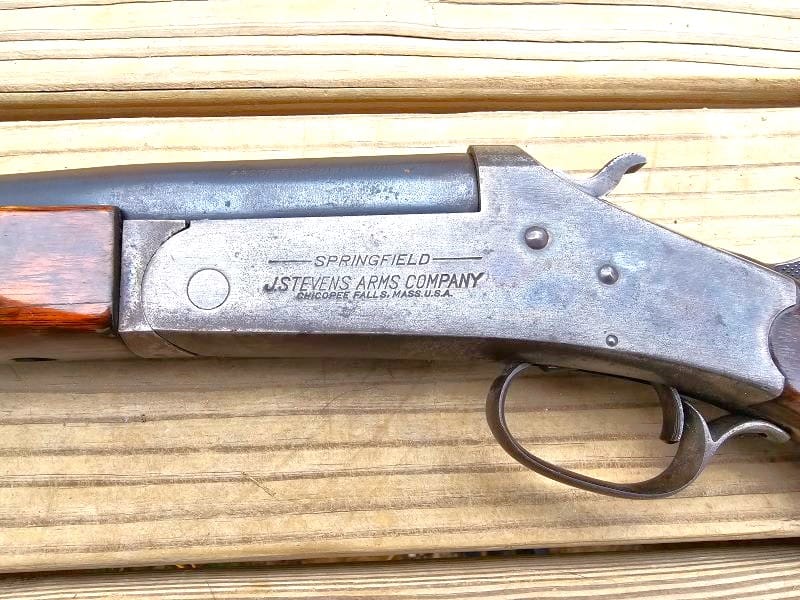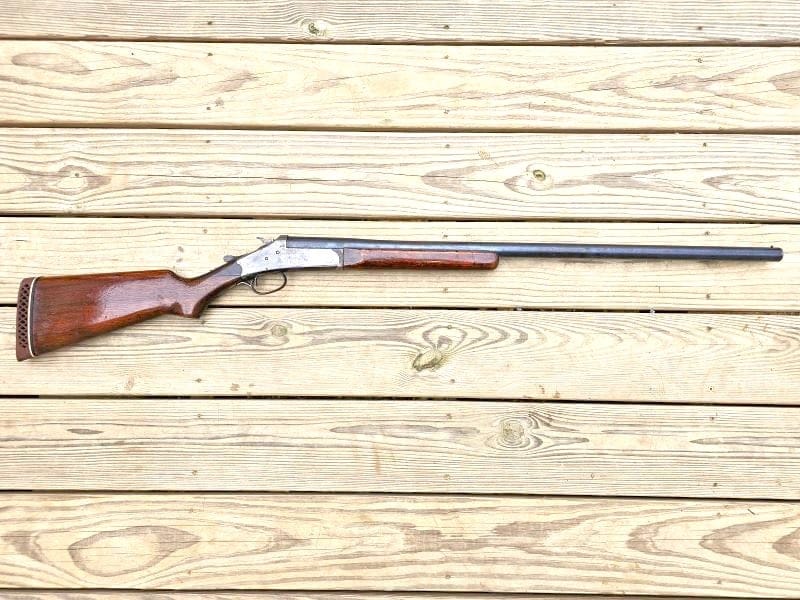Today, I’d like to take you back a bit as we take a gander at the Stevens single-shot 12-gauge shotgun. It’s nothing special, but it’s old and it’s fun. And honestly, I didn’t know much about it before I took it out for a bit of range time. From my research, it appears to be the 907B model (I had to peruse the internet because the firearm has no model number or serial number), but that’s yet to be verified.

Overview
The left side of the receiver is marked, “Springfield, J. Stevens Arms Company” and “Chicopee Falls, Mass, USA.” Research indicates that this name was used up until April 1, 1920, when Savage Arms purchased Stevens. So I’m assuming this shotgun was made before that date, though I’ve not confirmed that.
The right side of the barrel is marked, “Selected Forged Steel,” and on the right, “Proof Tested 12 Gauge.” That concludes the markings on this gun.

Since the shotgun has no model markings, this is the best information I could glean after researching on the internet. I could be mistaken about the model and time frame, though. After all, firearm companies weren’t always great at keeping records prior to the National Firearms Act of 1934.
The Action
It really doesn’t get much simpler than the 907B. You push the thumb lever over to open the action, tilting the barrel down. If there’s a round in the chamber, it ejects automatically. When the chamber is empty, simply slide in a shell, close the action, cock the hammer with your thumb, and the gun is ready to fire. Simple is as simple does.
There is no safety. However, the hammer is of the rebounding variety. The trigger blocks the hammer from hitting the firing pin unless the trigger is pulled.

If hunting in the field, a safe way to carry the shotgun would likely be with the action open. It can be quickly snapped shut as the gun is brought to the shoulder should game be sighted.
Another possibility would be to carry it with the hammer down. Be warned, though, that the hammer spring is very stiff and some effort is required to cock the hammer. This seems to be a trait with this model of shotgun, as others report similar findings.
Furniture
The stock appears to be Walnut, and is still fairly nice in appearance, giving the shotgun a warm look. I’m not sure it would be considered high-grade by today’s standards, but it’s a nice touch. That’s one thing about early 20th-century firearms; they often feature very nice furniture of a caliber rarely seen these days.

Uses
Hunting/Target
The Stevens shotgun is a no-frills gun that was marketed for budget-minded people. Its sole purpose was basically for hunting and putting meat in the pot at home. The action is about as simple as you can get, and the finish (what’s left of it) is barebones. It’s a real working man’s gun that would be propped behind the door at home and not babied out in the elements.

A friend picked this shotgun up for a song locally, so prices are incredibly modest. In fact, the inexpensive price is one reason he was attracted to the gun – it was too good a deal to pass up.
The 30-inch barrel keeps groups very tight for quite a distance. We didn’t test the Stevens to the limit of its range, but rest assured, it will reach out there.
At around 5.5 pounds, this is a very light shotgun. Consequently, the recoil is stout. There’s a decent recoil pad on the butt of the stock, but recoil is still enough that you’re not likely to take this gun to the range for pleasurable plinking sessions. Lower recoiling bird shot, however, is not punishing. If you’re going the buckshot route, I suggest some form of low recoil buckshot, such as Federal’s Low Recoil OO Buckshot.
Self-Defense?
Well, it’s far from the tactical 12-gauges that are so popular today. Certainly no rail system, fancy sights (the 907B merely has a bead up front), tactical black finish, or Velcro.
So, I got to thinking…could a person realistically use this gun for self-defense? I mean, it does fire a round of 12-gauge ammo. Personally, I’d opt for something with a higher capacity. But perhaps someone can’t afford much else, and this little gun is all they’ve got. Not everyone is made out of money, and some folks just want a simple tool to keep the Boogey Man at bay without breaking the bank. A gun like this costs well under $100, and for some people, that’s a substantial sum.
While the rate of fire isn’t going to be high at all, a well-placed shot of 12-gauge ammo is nothing to sneeze at. Against a home invader, I think a person could make this work. Mind you, it’s far from optimal, given that it will be a one-round-at-a-time affair. But the ejection when the action is opened helps speed up the process a little bit.
Aside from that, the 30-inch barrel makes it a little long for handling inside a house. On the other hand, that barrel keeps the pattern very tight, so close-range wounds with this gun will be devastating.
All in all, if I had to, I could make it work for defense. It won’t be my optimal choice, and I’d have to make that one precious shot count. But a home invader’s day would be ruined if he came after me and I was armed with this 12-gauge.
How Does It Handle?
As it is in its current configuration, the overall length is just a tad over 46 inches. The gun has a slightly muzzle-heavy feel, which actually isn’t bad at all. In fact, I’m amazed that they were able to make this gun feel as good as it does in the hand. When you throw it up to your shoulder, it shoulders very naturally and fluidly. Overall, Stevens did a nice job designing this very simple, economic shotgun.
The trigger pull is somewhat heavy, but there is no creep at all and the break is very crisp. Overall, it’s a decent trigger, especially for what it’s intended for, which is tromping through the woods in search of game or around the farm to dispatch predators.
Final Thoughts
This decades-old shotgun has a charm from days gone past. Simply designed and executed, it’s not fancy and was intended to be an inexpensive tool for Mr. Everyman. To that end, Stevens succeeded in a big way. And they even managed to include some nice-looking Walnut furniture. I’m still amazed every time I pick up a firearm from that earlier era, in that you can really see the pride of the maker in the gun. Even in those that weren’t made to be fancy, there is still a different feel than in most firearms made today.
Whether hunting for small game or fowl or defending hearth and home, this 12-gauge will still get the job done in the understated manner that it always has. Keep your eyes out for bargains like this one – they’re out there, and you should snap them up when they present themselves.


